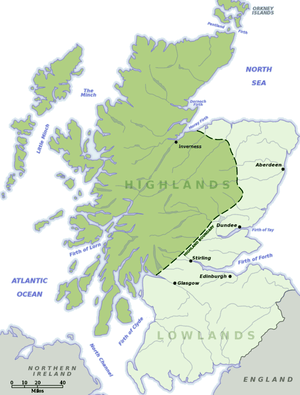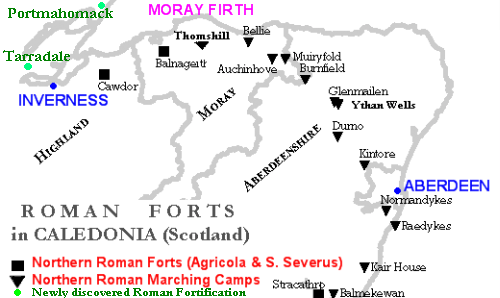Cawdor (Roman fort)

Cawdor (Roman Fort), located near the small village of Eastern Galcantray (15 miles east of Inverness), is suspected of being one of the northernmost Roman forts in Great Britain, though this evidence is controversial.[1]
History
In 1984, the site of an alleged Roman fort was identified at Easter Galcantray, south west of Cawdor, by aerial photography.[2]
The site was excavated between 1985 and 1990 and, although no Roman pottery or artefacts were found, several features were identified that seemed supportive of this classification:
Jones (1986a) interpreted the main structural phase within the (Cawdor) site’s history as potential evidence for the presence of a Roman military work. This assumption was based on a number of salient factors. These include: the rectilinear form of the enclosure ditch, with its V-shaped profile; the associated timber gate and corner tower; the presence of possible contemporary rectilinear timber buildings, which appear reminiscent in both size and form to barrack blocks; and finally, the dating evidence.[3] This, based on the one sigma calibrated range, suggests the slighting of the site during the late first century AD, which would correspond to the governorship of Agricola, or possibly his unknown successor.[4]
If confirmed, it would be the most northerly known Roman fort in the British Isles.[5] The possibility that Agricola reached the northernmost area of Scotland can be confirmed by discoveries north of Inverness, specifically at Portmahomack [6] and Tarradale in northern Beauly Firth,[7] but Romano-British scholars have been consistently reticent in confirming Jones' interpretation of the site.[8]
Agricola's Fort?
In the summer of 83 Agricola defeated the massed armies of the Caledonians, led by Calgacus, at the Battle of Mons Graupius.
Satisfied with his victory, Agricola extracted hostages from the Caledonian tribes and instructed his fleet to sail around the north coast, confirming (allegedly for the first time) that Britain was in fact an island.
He then may have marched his army to the northern coast of Britain,[9] and reached the Inverness area, in the vicinity of the Eastern Galcantray (Cawdor) Fort. However, the "small piece of Roman coarse ware found with burnt material at bottom of ditch", originally reported in 1985,[10] was subsequently found to be medieval,[11] so it is unlikely that the Roman army was responsible for the construction of the site (as alleged on the Roman-Britain web site ).
Indeed, although a radiocarbon test of material found in this Roman Fort gave a possible date of construction during the Agricolan campaign,[12] its interpretation remains problematic.[13]

Furthermore some scholars, like Roy,[14] Surenne,[15] Watt,[16] and Hogan[17] believe that the Battle of Mons Graupius was fought in 82 near the Roman Camps of Raedykes [18] or Glenmailen.[19]
But Vittorio di Martino (author of "Roman Ireland", about a possible Roman expedition to Ireland) believes that this Roman victory happened in the area southwest of Cawdor.[20]
See also
- Scotland during the Roman Empire
- Gnaeus Julius Agricola
- Roman Britain
- Inchtuthill
- Deers Den
- Normandykes
- Raedykes
Notes
- ↑ Roman Fort discovery at Cawdor/Eastern Galcantray
- ↑ G.D.B. Jones & I. Keillor, "Easter Galcantray", Discovery & Excavation Scotland 1984 (1984), p. 14: "On south bank of river Nairn, straight cropmark with gap in middle and suggestion of two more sides, truncated by river, at right angles to main mark."
- ↑ A single radiocarbon date of 1880 +/- 20 BP, obtained from a layer of charcoal in the re-cut western ditch.
- ↑ R.A. Gregory, "Excavations by the late G.D.B. Jones and C.M. Daniels along the Moray Firth littoral", Proceedings of the Society of Antiquaries of Scotland 131 (2001), pp. 177-222 , at p.204.
- ↑ Roman fort near Inverness Archived June 14, 2010, at the Wayback Machine.
- ↑ RCAHMS: Port A'Chaistell
- ↑ Google Book: Tarradale, a possible roman camp. p. 176
- ↑ G.S. Maxwell & D.R. Wilson, "Aerial reconnaissance in Roman Britain 1977-84", Britannia Vol. 18 (1987), pp. 1-48, at p. 34: "For the present, it may be noted that, viewed as crop-mark sites, neither [Cawdor nor Thomshill] sits happily in the established morphological categories of standard Roman military installations in North Britain". D.J. Breeze, "Why did the Romans fail to conquer Scotland?", Proceedings of the Society of Antiquaries of Scotland 118 (1988), pp. 3-22, at p. 8: "the suggested Roman context for the sites at Easter Galcantray [Cawdor] and Thoms Hill - Daniels 1986 and Jones 1986 - fails to convince; most of the evidence from the former site would better sit within a medieval context ..."
- ↑ Stan Wolfson 2002. http://myweb.tiscali.co.uk/fartherlands/appendix.html THE BORESTI : THE CREATION OF A MYTH In the manuscript of Agricola 38.2: "In finis Borestorum exercitum deducit - He led his army down into the territory of the Boresti" may be emended to: in finis boreos totum exercitum deducit - "He led his entire army down into the northern extremities"
- ↑ G.D.B. Jones & I. Keillor, "Easter Galcantray", Discovery & Excavation Scotland 1985 (1985), p. 27.
- ↑ R.A. Gregory, "Excavations by the late G.D.B. Jones and C.M. Daniels along the Moray Firth littoral", Proceedings of the Society of Antiquaries of Scotland 131 (2001), pp. 177-222, at p. 192: "This sherd of pottery was subsequently dated to 1300±140 AD (Dur87TL-2AS) by thermoluminescence."
- ↑ Excavations at Cawdor 1986
- ↑ Gregory, Proceedings of the Society of Antiquaries of Scotland 131 (2001), at p. 218: "Likewise, the single calibrated radiocarbon date retrieved from the ‘demolition deposit’ within the ditch, although partially spanning the Flavian period at both one and two sigma standard deviations (cal AD 80–130 (1 sigma): cal AD 80–220 (2 sigma) ), remains problematic. It is not, in itself, conclusive evidence that the site was occupied and abandoned during the late first century AD. Still less is it conclusive evidence that it was occupied and abandoned by the Roman military, particularly since no late first-century Roman pottery was recovered from this feature or from elsewhere on the site."
- ↑ William Roy, The Military Antiquities of the Romans in Britain, 1793
- ↑ Gabriel Jacques Surenne, 1823 Correspondence to Sir Walter Scott
- ↑ Archibald Watt, Highways and byways around Kincardineshire, Stonehaven Heritage Soc., Scotland
- ↑ C. Michael Hogan, Elsick Mounth, The Megalithic Portal, ed. A. Burnham.
- ↑ Raedykes
- ↑ Glenmaillen: Roman Camps of Agricola and Septimius Severus
- ↑ Di Martino, Vittorio. Roman Ireland p. 14
Bibliography
- Di Martino, Vittorio. Roman Ireland. The Collins Press. London, 2003.
- Jones and Keillar. Excavations at Cawdor. University of Manchester, 1986
- Hanson, William S. "The Roman Presence: Brief Interludes", in Edwards, Kevin J. & Ralston, Ian B.M. (Eds) (2003) Scotland After the Ice Age: Environment, Archaeology and History, 8000 BC - AD 1000. Edinburgh. Edinburgh University Press.
- Hanson, William S. Roman campaigns north of the Forth-Clyde isthmus: the evidence of the temporary camps, Proc Soc Antiq Scot, vol.109 142, 145 Edinburgh, 1980.
- Macdonald, G (1916) The Roman camps at Raedykes and Glenmailen, Proc Soc Antiq Scot, vol.50 348-359
- Maxwell, G S (1980) Agricola's campaigns: the evidence of the temporary camps, Scot Archaeol Forum, vol.12 34, 35, 40, 41
- Moffat, Alistair (2005) Before Scotland: The Story of Scotland Before History. London. Thames & Hudson. ISBN 0-500-05133-X
- Pitts, L. Inchtuthil. The Roman Legionary Fortress. Britannia Monograph Series 6 (1985)
- Robertson, A S (1976) Agricola's campaigns in Scotland, and their aftermath, Scot Archaeol Forum, vol.7 4
- St Joseph, J K (1951) Air reconnaissance of North Britain, J Roman Stud, vol.41 65
- Woolliscroft,D. and Hoffmann,B. The First Frontier. Rome in the North of Scotland (Stroud: Tempus 2006)
External links
- Excavations of Jones and Daniels
- RCAHMS: Cawdor Roman Fort excavations at Easter Galcantray
- The Roman Gask Project
- Temporary Marching Camp: Normandykes, Peterculter, Grampian (2004)
- Britannia - The Roman army and navy in Britain (55BC - 410AD)
| Wikimedia Commons has media related to Nairnshire. |
Coordinates: 57°30′44″N 3°59′21″W / 57.51213°N 3.98907°W